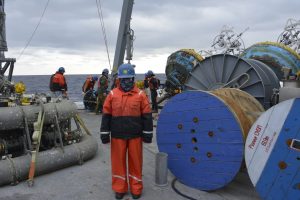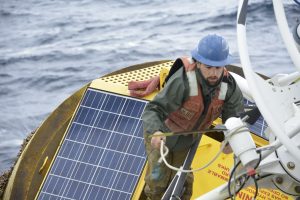After witnessing how hard the Pioneer 17 team and the crew of the R/V Neil Armstrong have worked over the past seven days, under sometimes quite arduous conditions, I found myself wondering why? Why should these folks work so hard, put in such long days, with intermittent sleepless nights (not to mention upset stomachs), to make sure the Pioneer Array can continually measure and send back ocean observations to shore?

Irene Duran dresses for the weather as she awaits her time to test instruments on recovered equipment.
The underlying reason is that there’s no way to improve understanding of complex ocean processes without real data. The ocean is too vast, under-sampled, and complicated to predict accurately, even with sophisticated models. Real, hard data are needed to identify the processes that take place within and above the water, figure out how these processes work and what influences outcomes. Only then can we begin to figure out how, or if, the ocean is changing and what some of the implications of this changing ocean may be.
Before our departure, I had the opportunity to hear Al Plueddemann, the principal investigator for OOI’s Coastal and Global Nodes of which the Pioneer Array is one, speak about the important science that is resulting from the Pioneer Array. I paraphrase Al’s discussion below but my takeaway is that the long days, nights, and lousy weather are worth it.
In short, Pioneer data are directly advancing our understanding of the ocean by helping to quantify the exchange processes between the shelf and slope, and how this exchange impacts their respective ecosystems and dynamics. The Pioneer Array is specific to the New England shelf, but the implications are far-reaching for other, similar systems around the globe.
Using Pioneer Array data, scientists now know more about nutrients available in the area, how carbon is cycled, where primary production takes place, the role of the Gulf Stream, and the impact of extreme weather events—like the storm that delayed our departure. All of these scientific advances are helping to improve ocean models that are used for everything from predicting weather to where to fish to the direction oil spills might flow or hurricanes advance.

Nico Llanos climbs aboard a recovered Pioneer buoy to ensure it is safely secured.
Many scientific papers have been published using Pioneer data. Topics covered include analyses of temperature and salinity in the shelf/slope region, trends happening at the shelf break, the presence of warm core rings, and the impact of marine heat waves on marine life, and ultimately their implications for the fishing community. Combining Pioneer data with other data sources, scientists now also better understand the evolution of phytoplankton blooms on the continental shelf, how they move, grow, alter water chemistry, and affect food web dynamics.
According to Al, there is no end in sight as to how Pioneer data can be used and combined with other data sources to help us better understand the changing ocean. And, it seems as though there’s no better time than now to get a handle on the changing ocean, regardless of what it takes to deliver the data.
Images and Text by Darlene Trew Crist©WHOI.
Recent Updates